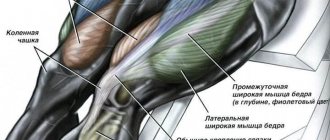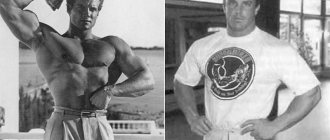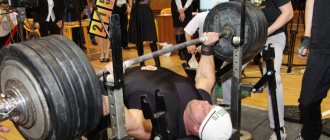The system called “German volume training” (abbreviated as HOT) is not as beautiful as the Doggcrap system (Dante Tradell), but everyone notices the result of its use. But no one loves her. Well, or almost no one. Why?
It’s all very simple: beginners often simply don’t know about it, because both the popular Muscle & Fitness and the no less popular Men’s Health are somehow accustomed to bypassing the NOT system. But even if our newcomer knew about German volumetric training, he would definitely not use it: well, it’s not cool to work with such ridiculous weights! And he had never heard the saying “When you enter the gym, leave your ego at the door.”
True, both “advanced” guys and those who train not “for themselves”, but for the sake of victories on the competitive podium, also do not favor NOT. The reason for this is the mortal melancholy into which this system drives you at the very first training session. You don’t want to go to the gym, knowing that a dull and completely unattractive “German” is waiting for you there.
Warning
German volume training is only suitable for athletes with at least a year of serious training experience - at least 150 hours of training and a gain of at least 10 kilograms of pure muscle mass.
The athlete must have experience performing at least five sets of one exercise and experience performing sets of 10-20 repetitions.
If you are used to doing 3 sets per exercise or have always preferred to work on strength up to 5 repetitions per set, then German volume training will be a real shock for your body and especially for your heart.
I never tire of reminding my clients of the word “working in.” It is better to first slowly accustom your body to doing 10 approaches per exercise without taking into account time, and only then test your body in German volume training.
Have you ever tried doing 5 sets of 10 reps with a minute of rest? Do you know how to do exercises 20 times? For example, can you do 20 pull-ups?
If you can do 20 pull-ups, you can try German volume training.
Can you do more than 20 pull-ups? How long have you been training? Write a comment.
Create a training plan for a week for free
Drying
This system would be very suitable for use at the “drying” stage. In this case, you can increase the volume of the load by adding one more exercise per muscle group in the same mode. Depending on the recovery abilities in the second exercise, the volume may be slightly less, for example, 5x10. Although many should cope with all 10x10. The advantage of using the system on a “drying” basis is that it avoids working with large weights. This, on the one hand, reduces the risk of injury that is possible with dietary restrictions, and on the other hand, it allows you to cope with the entire planned volume of load, and, of course, spend a lot of energy.
The Birth of German Volume Training
German volume training has its roots in Germany. It began to be promoted by the German weightlifting coach Rolf Feder in the mid-70s of the twentieth century.
Legs are very important in weightlifting. And among his students, champions with big legs began to appear. Everyone began to ask why the legs were so big and Rolf began to tell how in the off-season he trains weightlifters to gain mass.
Which muscles are your priority in training and which ones are lagging behind in your body? Write a comment.
Coordination and neuromuscular conduction are important in the barbell. But it is better to develop coordination and conductivity with good muscle volumes. And Rolf discovered that increasing the volume of training leads to increased muscle size.
Create a training plan for a week for free
Volume training in weightlifting
Typically, weightlifters do 5-8 sets of 3-4 repetitions in one exercise.
We always did 4 exercises, 8 sets of 3-4 repetitions. In total, we did about 100 lifts during the workout.
One day the coach came after talking with someone and said that now we will do an experiment. We started doing all the exercises in 5 sets and 10 lifts.
Four exercises of 50 lifts resulted in 200 lifts per workout instead of 100.
The weight of the weights decreased by 10-20%, but the volume increased by 100%. It was very difficult.
In addition, the pace of the approach has changed. Typically we would do a set of 3 lifts and rest for 3 minutes.
Now we rested between lifts for 10-30 seconds. The approach could take 5 minutes or more. There was also a crossfit tabata.
We did 5 sets of an exercise for 30 minutes and 4 such exercises per workout. Two hours of hard training 5 times a week. 10 hours of hell a week. This is extensive training. 1000 lifts per week with weight over 60 percent of the record.
Do you have any records in any exercises? Write a comment.
The table shows the entire weekly training volume. 20 exercises, 100 sets, 1000 lifts. And all with an intensity of 60-70% of the record.
High Volume Training Research
The benefits of volume training by Charles Poliquin have been experimentally proven by scientists from the University of Central Florida. The researchers recruited 10 athletic men who trained their legs using two different methods. One half of them were asked to perform exercises with a weight of 70% of the maximum for 10-14 repetitions with a minute's rest, and the other half were asked to perform the same exercises with a weight of 90% and rest for about three minutes.
With high-volume training, scientists noted a higher level of production of the growth hormone somatotropin, but the concentration of cortisol, which destroys muscle, was greater. Otherwise, both methods showed approximately the same results.
#Ivan Vodyanov #volume training #workouts
Previous How the cars of the future will drive
Next Gymnastics for joints: basic exercises
Leave a comment (Cancel)
The essence of German volume training in bodybuilding
The essence of NOT (German volume training) is simple - do 100 repetitions in one exercise. Typically this is 10 sets of 10 repetitions. The weight used is 60 percent of the rep max or whatever the athlete can lift 20 times in one set.
Note that 10 reps for a working set is half of the 20 rep max. Very similar to the half-hearted principle. What I mean is that home and backyard bodybuilders who train with their bodies can easily adopt the principles of German volumetric training.
If with the selected weight 60% of the record the athlete completed all 100 repetitions, then in the next workout you need to increase the weight of the weight.
How often do you add weight to your work? Write a comment.
The principle of 10 approaches or 100 repetitions is used in basic exercises: bench press, pull-ups and squats. All sorts of small exercises: biceps, abs or calves curls, are trained in three approaches.
Create a training plan for a week for free
A more advanced version of GVT.
This system is called the four percent method. You increase the load by 4 to 5 percent each workout for two workouts in a row, and decrease the target reps by one for each increase in weight.
You then decrease the weight by 4 to 5 percent and increase the reps back to the original starting point. Since we're playing with numbers here, let's look at an example that will clearly illustrate this method.
Let's say you can overcome 40 kilograms by performing 10 technical repetitions of barbell curls. But you can’t increase the number of repetitions or weight in this exercise. Here is a sample procedure that will increase all indicators in weighted arm curls:
- Workout 1: 10 sets of 6 reps, weight 50 kg.
- Workout 2: 10 sets of 5 reps, weight 52 kg.
- Workout 3: 10 sets of 4 reps, weight 54 kg.
- Workout 4: 10 sets of 6 reps, weight 52 kg.
- Workout 5: 10 sets of 5 reps, weight 54 kg.
- Workout 6: 10 sets of 4 reps, weight 56-57 kg.
- Workout 7: Challenge day.
Workout 7 - test day. At this point, you should be lifting a 54-kilogram biceps barbell for 10 technical reps. Over the course of six workouts, you've gained almost 10% of your weighted curl strength. Of course, this method can also be used on the bench press, squats, or any other multi-joint exercise in which you want to improve strength.
Let me make it clear again, start with the first program and work on it for six weeks. Lower the intensity by doing the second program for three weeks. Then, if you want to push your strength capabilities to the limit, explode your muscles with the advanced GVT program.
NOT and cycles
Experts recommend doing volume training with micro or mesocycles. Rumor has it that someone in volume training gained 4-5 kilograms of pure muscle in just 2-3 weeks. (It is normal to gain 4-5 kilograms of muscle in one year in the second year of training)
After 2-3 weeks, experts do not recommend using German volume training, because they see no point in training if 2 kilograms of muscle do not grow per week.
Experts recommend alternating German volumetric training with abandoned training.
I don't recommend training too little. You can play with volume and intensity within thirty percent, but not three hundred. For example, volume training means training a muscle group once every five days, and a failed muscle group once every twenty. Training a muscle once every 3 weeks is too little, even if the intensity is very high.
How often do you train a muscle group and why? Write a comment.
Create a training plan for a week for free
Advantages and disadvantages of volumetric training
Periodic use of volumetric training can be beneficial, because it will build not only muscles, but also energy reserves. Our body, as we know, has the ability to adapt to loads, and if in response to heavy weights it increases muscle tissue, then in response to a high volume of load it will begin to store more glycogen.
However, performing large volumes of work exhausts the body and requires long-term recovery - you cannot train extensively and often at the same time. Full recovery in a short time is impossible without the use of prohibited pharmacology. So don’t think that the methods of great athletes will work for you, because many of them used doping to achieve results.
Split in German volume training
Experts believe that German volumetric training, unlike failure tripod training, is not highly intense - although the load is selected so that failure occurs within 100 repetitions - then, unlike failure training, one muscle group can rest not for 3 weeks after one workout, but only 5 days.
In general, failure in bodybuilding is a subjective term. Sometimes I use a heart rate monitor during strength training and it shows how much my muscles are burning. This adds objectivity to conversations about rejection.
What do you mean by refusal? Write a comment.
Why exactly 10x10
In fact, “10x10” is just “number magic”. Subjectively, “10x10” is perceived as more impressive, more presentable than, for example, 8x10 or 9x8. And the total number of repetitions is 100, psychologically more comfortable than, for example, 90. Psychologically! It is worth recognizing that the numbers can be quite varied. The only condition for any combination is to ensure a large volume and reach “failure” only in the last approaches. For some, numbers other than 10x10 will be more suitable; individual settings always have a place in any training program. You can try 8x10, 8x12, 10x12, 12x10, 12x8.
A typical split in German volume training looks like this:
Day 1 chest, back Day 2 legs, abs Day 3 Rest Day 4 arms, deltoids, forearms, trapezius Day 5 Rest Day 6 The beginning of a new cycle.
Please note that the training cycle is five-day and is not tied to the days of the week, so supporters of German volume training should, if possible, avoid weekdays and weekends, work and family. You remember that our weightlifting training had rest days on days of the week, because everyone was studying, working and living with families.
Are your training plans tied to the days of the week? Write a comment.
News
Author: Dmitry Yakovina
There is one very great saying in bodybuilding: “You can either work hard or work long.” The point is that if you train really hard, giving 100% in every set, that is, hitting the target muscle and achieving failure, then you simply will not be able to do a large number of such approaches. Accordingly, if, when training any muscle group, you easily cope with a large number of approaches, then this only indicates that you are not working hard, even if you think differently. So, German volumetric training is the same case when an athlete deliberately, without deceiving himself, works not hard, but a lot. Now let's get acquainted with this training system and evaluate it critically. To avoid confusion about where and whose words are quoted, the quoted text obtained from open sources will be italicized. “And so, 10 sets of 10 repetitions ... As a result, you will get a uniquely high volume of training load: 100 basic repetitions. It is common knowledge that the key factor causing hypertrophy (thickening) of muscle fibers is the extreme amount of strength work done in training.
In other words, you need to do as many repetitions as possible. As a result, the muscle experiences stress, which cannot be neutralized by conventional biochemical methods. And then she has to change the trophism of her tissue - thicken the muscle fibers. “Plump” fibers are much stronger. The German training formula compresses the muscles so powerfully that subsequent hypertrophy becomes inevitable.” One cannot but agree with the author of these words regarding the fact that training volume is a factor causing hypertrophy. Indeed, the degree of changes inside the muscle cell required to trigger protein synthesis that occur under the influence of load increases from approach to approach. This is expressed both in an increase in the secretion of anabolic hormones and in an increase in the activity of signaling systems.
However, as the load volume increases, negative factors also accumulate, which transform training stress into a tool for destroying the internal environment of muscle cells, including its protein structures. The task of each individual is to search for the “golden mean”, that is, such a volume that gives him a strong incentive for hypertrophy and is not overly destructive. For this reason, we can notice a certain difference in the number of working approaches for a particular muscle in athletes’ training programs, which ranges from 6 to 16. We will never see programs consisting of 20, 30 or more approaches. Simply because they are not suitable for anyone due to the fact that they destroy much more than we are able to build. The creators of NOT made an attempt to make high training volume as safe as possible from a catabolic point of view. “A lot, but not hard.” What does this mean? The fact is that out of the 10 recommended approaches, only the last couple are performed to failure. All previous approaches end long before it at the 10th repetition, which is facilitated by the correctly selected weight of the weight.
But due to limited rest, with each approach it becomes harder and harder to perform 10 repetitions, as under-recovery accumulates, or more precisely, the muscle becomes more and more acidified with lactic acid.
As a result, after 7-8 sets we come to the point where 10 repetitions become the maximum possible for us, despite the fact that with fresh strength the weight of the weight would allow us to do all 15-20 repetitions. “From the first to the last hundredth repetition, you will use the same working weight. If it is too small, hypertrophy will not work. If the weight is excessive, then you definitely won’t be able to overcome ten sets. The working weight of the projectile should be 60-70% of 1RM. For the vast majority of amateurs, this is the same weight with which they can overcome 15-20 repetitions to failure. Rest after each approach for one minute. Sets 1-3
— The weight seems ridiculous.
It is impossible to believe that the system can bring at least some benefit to the muscles. Sets 4-5
- Gets a little harder.
You can still easily perform 10 repetitions per set, but fatigue is already showing itself. Sets 6-7
- Here you have to agree that the system is not as simple as you thought at first.
Each new repetition becomes more and more difficult for you. Sets 8-9
- It's impossible to believe that you will be able to complete all 10 reps.
However, a small miracle happens. A second wind opens inside you, and although you collapse from fatigue, you bring both sets to the victorious tenth repetition. Set 10
- You feel that the body has “unsealed” its secret resources.
You finish the last set feeling like superman! At this point, work on one muscle group is completed and you can move on to another. Just one exercise per muscle or muscle group, 10 sets of 10 repetitions. The number of muscles or muscle groups subjected to load in one workout is 2-4. It couldn't be simpler. Weekly training scheme: Day 1:
Legs, calves, abs 1) Squats: 10/10 2) Leg curls: 10/10 3) Seated calf raises: 3/20 4) Reverse crunches: 3/20
Day 2:
Chest, back 1) Dumbbell bench press: 10/10 2) Bent over dumbbell row: 10/10 3) Crossovers: 3/10 4) Seated rows: 3/10
Day 3:
Rest
Day 4:
Triceps, biceps, deltoids, press 1) Seated dumbbell press: 10/10 2) Barbell curls: 10/10 3) Dips: 3/10 4) Fitball crunches: 3/20
Days 5-7:
Rest Analysis From a pedagogical point of view, the system 10x10 is very easy to understand due to the small number of variables. A minimum of exercises in the program and practically one single mode (with the exception of small muscle groups: calves and abs). If desired, you can periodically replace the main movement for each muscle group with another, but do not forget that a variety of exercises is not absolutely necessary. Physiologically, HOT is indeed a fairly gentle scheme that does not cause excessive destruction in practice, which is expressed in the absence of pain after training and rapid recovery. Increased blood circulation in working muscles increases the likelihood of interaction of anabolic hormone molecules with the corresponding receptors in muscle cells. A number of “steroid gurus” at one time spoke out in favor of volumetric, pump training for “chemist” athletes precisely for this reason - “to pump more hormones into the muscles.” There is a great deal of truth in their words. HOT provides a large volume of load, but at the same time protects the muscles, since out of 10 approaches only a small part of them creates metabolic stress. However, the system will be useful for “straight people” too. Despite the fact that the first approaches, in terms of the degree of impact on the muscles and the body as a whole, can be classified as warm-up, mechanical stress on the muscles itself can stimulate protein synthesis.
There is a phenomenon called signaling processes, or molecular signaling. I quote: “For most cell types, a number of mechanisms have been discovered that mediate the transfer of information from hormone receptors and other humoral regulators, as well as from the synapse and depolarized membrane to nuclear transcription regulators, which determine the selective activity of certain genes, and, accordingly, the selective expression of those or other proteins. In muscle cells, those signaling systems that provide the transmission of information about the changed MECHANICAL state of the cell are especially important.
For example, if a fiber actively contracts for a long time, but does not bear a heavy load, then mitochondrial proteins, slow isoforms of myosin, are synthesized. If the fiber contracts, periodically repeating the generation of near-maximal forces, the genes of growth factors are activated, triggering intense protein synthesis on ribosomes.” (A.I. Grigoriev, B.S. Shenkman “Skeletal muscle in an unsupported world”, State Scientific Center “Institute of Medical and Biological Problems of the Russian Academy of Sciences”). Work with weights of 60-70% of 1 RM is intense enough to stimulate the synthesis of contractile proteins in intermediate and glycolytic muscle fibers even in the absence of metabolic stress, although we obviously will not see great results. But taking into account the fact that the second half of the approaches begins to cause metabolic stress, we will get a full range of effects on the muscle cell and a stronger stimulus for protein synthesis. At the same time, the volume of “stressful” approaches is not large, which will allow the “natural” to ensure the predominance of synthesized protein over that destroyed during the training process. That is, get an increase in hypertrophy. Thus, the 10x10 system can be recommended for athletes, both those who use pharmaceutical support and those who do not. In the first case, the return will be significantly higher. Drying
This system would be very suitable for use at the “drying” stage.
In this case, you can increase the volume of the load by adding one more exercise per muscle group in the same mode. Depending on the recovery abilities in the second exercise, the volume may be slightly less, for example, 5x10. Although many should cope with all 10x10. The advantage of using the system on a “drying” basis is that it avoids working with large weights. This, on the one hand, reduces the risk of injury that is possible with dietary restrictions, and on the other hand, it allows you to cope with the entire planned volume of load, and, of course, spend a lot of energy. Why exactly 10x10
In fact, “10x10” is just “the magic of numbers.” Subjectively, “10x10” is perceived as more impressive, more presentable than, for example, 8x10 or 9x8. And the total number of repetitions is 100, psychologically more comfortable than, for example, 90. Psychologically! It is worth recognizing that the numbers can be quite varied. The only condition for any combination is to ensure a large volume and reach “failure” only in the last approaches. For some, numbers other than 10x10 will be more suitable; individual settings always have a place in any training program. You can try 8x10, 8x12, 10x12, 12x10, 12x8.
Variation of German volume training from Charles Poliquin
You see only two four exercises per workout and a total of 26 approaches.
Between super series you need to rest 90 seconds. 60 seconds between sets.
The pace of movement in the super series is 4-0-2-0. The weight is lowered for four seconds and the resting step (0 sec) is raised for 2 seconds. Then, without delay (0 sec), it lowers again.
In assist movements, the weight is lowered for 3 seconds instead of two.
Poliquin recommends training this way for 30 days - 6 cycles - 6 workouts. Next 100 repetitions is better to turn into 60 repetitions. And even better, change the exercises.
The second option according to Poliquin looks like this:
Also 4 exercises and 26 approaches. Rest is the same 60 and 90 seconds.
The pace of the exercises is very slow: 5-0-10-0 for basic exercises and 3-0-10-0 for auxiliary exercises.
The weight of the weight is selected so that the athlete can perform 12 repetitions in one approach.
Now you understand why sometimes big muscles are dumb muscles - slower muscles. To increase volume you need to slow down. Muscle volume can compete with muscle speed. This is important to know for those who want to be Bruce Lee and Schwarzenegger at the same time.











